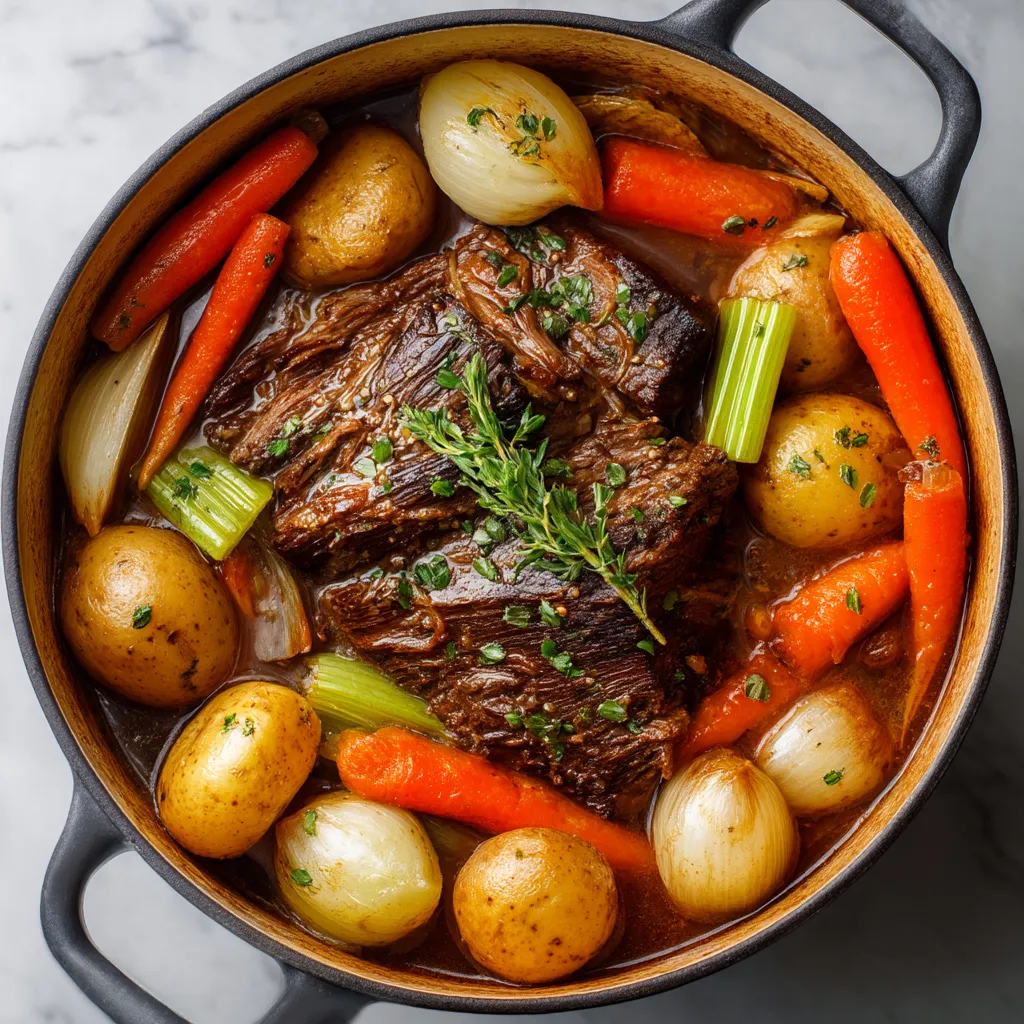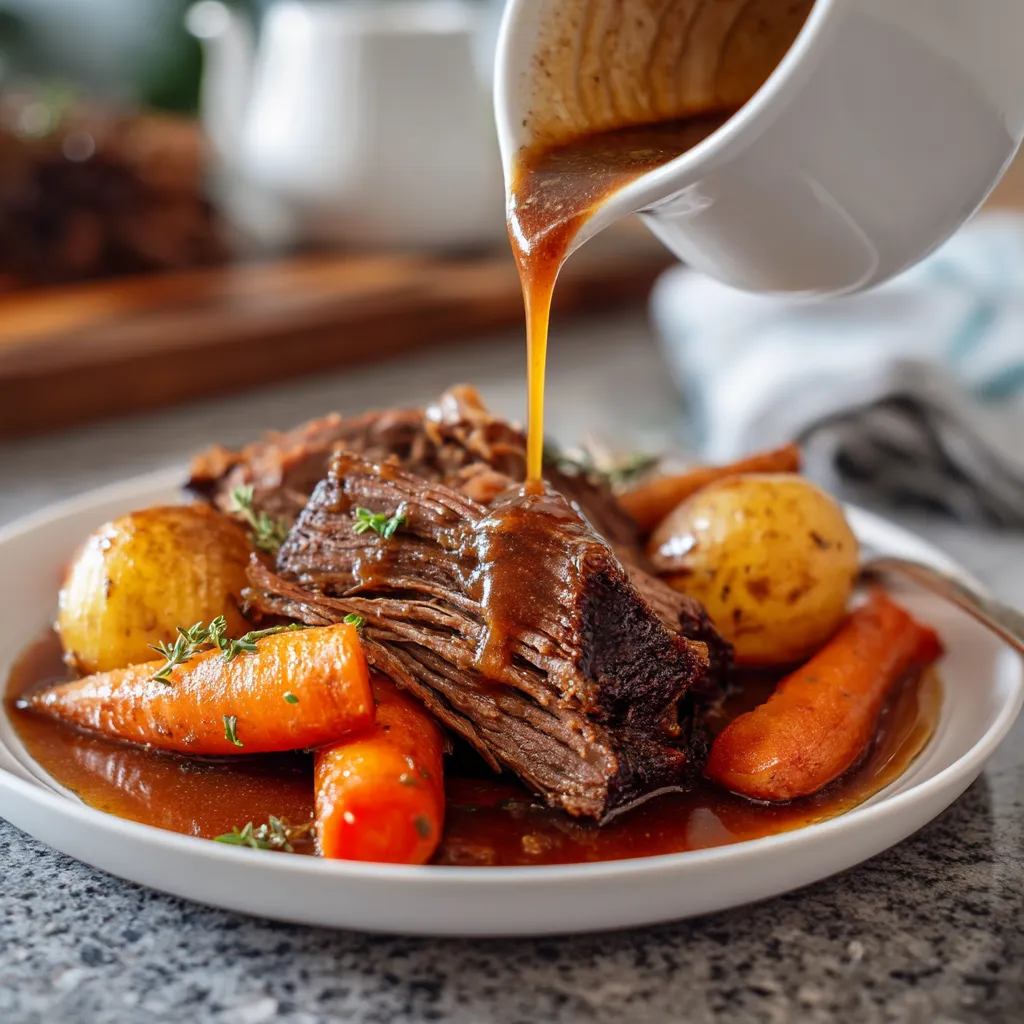 Save to Pinterest
Save to Pinterest This classic pot roast with fresh garden carrots transforms humble ingredients into an extraordinary family meal. The slow braising process creates fork-tender beef and vegetables infused with rich, savory flavors that embody true comfort food. Perfect for Sunday dinners or special occasions, this timeless recipe never disappoints.
I first made this pot roast when my in laws were visiting during a particularly cold autumn weekend. The incredible aroma filled our home all afternoon, and my father in law who rarely comments on food declared it the best pot roast he had ever tasted.
Ingredients
- Beef chuck roast: The marbling in chuck breaks down during slow cooking, creating incredible tenderness and flavor. Look for a well marbled piece with good coloring.
- Olive oil: Creates the perfect sear on our beef that locks in moisture and builds flavor. Use a good quality oil with a high smoke point.
- Fresh garden carrots: Their natural sweetness balances the savory elements. Choose firm carrots with vibrant color for best flavor.
- Baby potatoes: These hold their shape during long cooking while absorbing the rich broth. Select similar sized potatoes for even cooking.
- Onion and garlic: These aromatics create the flavor foundation. Look for firm onions and plump garlic cloves.
- Dry red wine: Adds depth and helps tenderize the meat. Cabernet Sauvignon or Merlot work beautifully here.
- Beef broth: Forms the base of our braising liquid. Homemade is ideal, but a good quality store bought works well too.
- Tomato paste: Adds richness and umami depth. A little goes a long way in building complex flavor.
- Fresh herbs: Rosemary and thyme infuse the dish with aromatic notes. Fresh herbs make a noticeable difference here.
Step-by-Step Instructions
- Prepare and Sear the Roast:
- Pat your chuck roast completely dry with paper towels. This ensures a proper sear. Season generously with salt and pepper on all sides. Heat olive oil in your Dutch oven until it shimmers. Place the roast in carefully and let it sear undisturbed for a full 3 to 4 minutes per side until a deep golden brown crust forms. This initial browning creates the foundation of flavor for the entire dish.
- Build the Aromatic Base:
- Remove the seared roast to a plate and add your onion wedges, smashed garlic cloves and celery to the hot pot. Cook them in the beef drippings for 4 to 5 minutes, stirring occasionally. The vegetables should soften slightly and pick up some color. This step releases their flavors and creates the aromatic foundation for your braising liquid.
- Create the Braising Liquid:
- Add tomato paste directly to the vegetables and cook for a full minute to caramelize it slightly. Pour in your red wine and use a wooden spoon to scrape all the flavorful browned bits from the bottom of the pot. This deglazing step incorporates incredible flavor into your liquid. Add beef broth and Worcestershire sauce, stirring to combine everything into a rich braising liquid.
- Assemble and Braise:
- Return the seared roast to the pot, nestling it into the liquid. Arrange your carrots and potatoes around the meat, not on top, so they cook properly in the liquid. Add your fresh herb sprigs and bay leaves. Bring everything to a gentle simmer on the stovetop, then cover with a tight fitting lid and transfer to your preheated oven. Let it braise undisturbed for 3 hours, during which time the tough connective tissues in the meat will break down into luxurious gelatin.
- Finish and Serve:
- Once the meat is fork tender, carefully transfer the roast and vegetables to a serving platter. If desired, simmer the remaining liquid on the stovetop for 5 to 10 minutes to reduce it into a more gravy like consistency. Pour some of this enriched braising liquid over the meat and vegetables before serving. The meat should pull apart easily with just a fork.
 Save to Pinterest
Save to Pinterest My grandmother always added a splash of balsamic vinegar right at the end of cooking her pot roast. This little trick adds a subtle tang that balances the richness beautifully. I continue this tradition with my own family, and that final touch makes all the difference between a good pot roast and an unforgettable one.
Make Ahead and Storage
This pot roast actually improves with time, making it perfect for meal prepping. You can cook it entirely the day before serving, let it cool completely, then refrigerate overnight. The flavors meld beautifully, and the fat rises to the top where it can be easily removed before reheating. To reheat, warm gently in a covered pot at 325°F until heated through, about 30 minutes. Leftover pot roast will keep in the refrigerator for up to 4 days or can be frozen for up to 3 months in airtight containers.
Serving Suggestions
While this pot roast is a complete meal on its own, a few thoughtful sides can elevate it further. Crusty bread is essential for soaking up the rich braising liquid. A simple green salad with a bright vinaigrette provides welcome contrast to the richness of the meat. For special occasions, serve over buttered egg noodles or creamy mashed potatoes to catch every drop of the savory sauce. A glass of the same red wine used in cooking makes for a perfect pairing.
 Save to Pinterest
Save to Pinterest Variations and Substitutions
This recipe welcomes adaptations based on what you have available. For a non alcoholic version, simply replace the wine with additional beef broth and a tablespoon of red wine vinegar. Parsnips make an excellent addition or substitute for carrots, adding a subtle sweetness. Mushrooms can be added during the last hour of cooking for earthy depth. For herbs, dried versions work in a pinch use one teaspoon each of dried rosemary and thyme. In warmer months, try adding fresh peas or green beans during the final 30 minutes of cooking for a splash of color and freshness.
Common Recipe Questions
- → Can I make this pot roast in a slow cooker instead?
Yes! First sear the meat and sauté the vegetables as directed, then transfer everything to your slow cooker. Cook on low for 8-10 hours or high for 5-6 hours until the beef is fork-tender. You might need to reduce the liquid separately on the stovetop at the end if you want a thicker sauce.
- → What's the best cut of beef for pot roast?
Chuck roast is ideal because it has excellent marbling that breaks down during slow cooking, resulting in tender, flavorful meat. Other good options include brisket, round roast, or bottom sirloin, though cooking times may vary slightly depending on the cut.
- → Can I skip the red wine in this dish?
Absolutely. While red wine adds depth of flavor, you can substitute with additional beef broth. For a similar complexity, add 1-2 tablespoons of balsamic vinegar to the broth. The dish will still be delicious without alcohol.
- → How do I know when my pot roast is done?
The pot roast is done when it's fork-tender, meaning a fork easily slides into the meat with little resistance. The meat should appear to be falling apart slightly. This typically takes about 3 hours at 300°F, but could take longer depending on the size and shape of your roast.
- → What's the best way to store and reheat leftovers?
Store the meat and vegetables with some of the braising liquid in an airtight container in the refrigerator for up to 4 days. For best results, reheat gently in a covered pot on the stovetop over medium-low heat. You can also microwave portions, but cover them and use medium power to prevent the meat from becoming tough.
- → Why should I sear the meat before braising?
Searing creates a caramelized crust on the meat through the Maillard reaction, which adds tremendous flavor to both the beef and the braising liquid. This step is crucial for developing the rich, complex taste that makes pot roast so delicious.